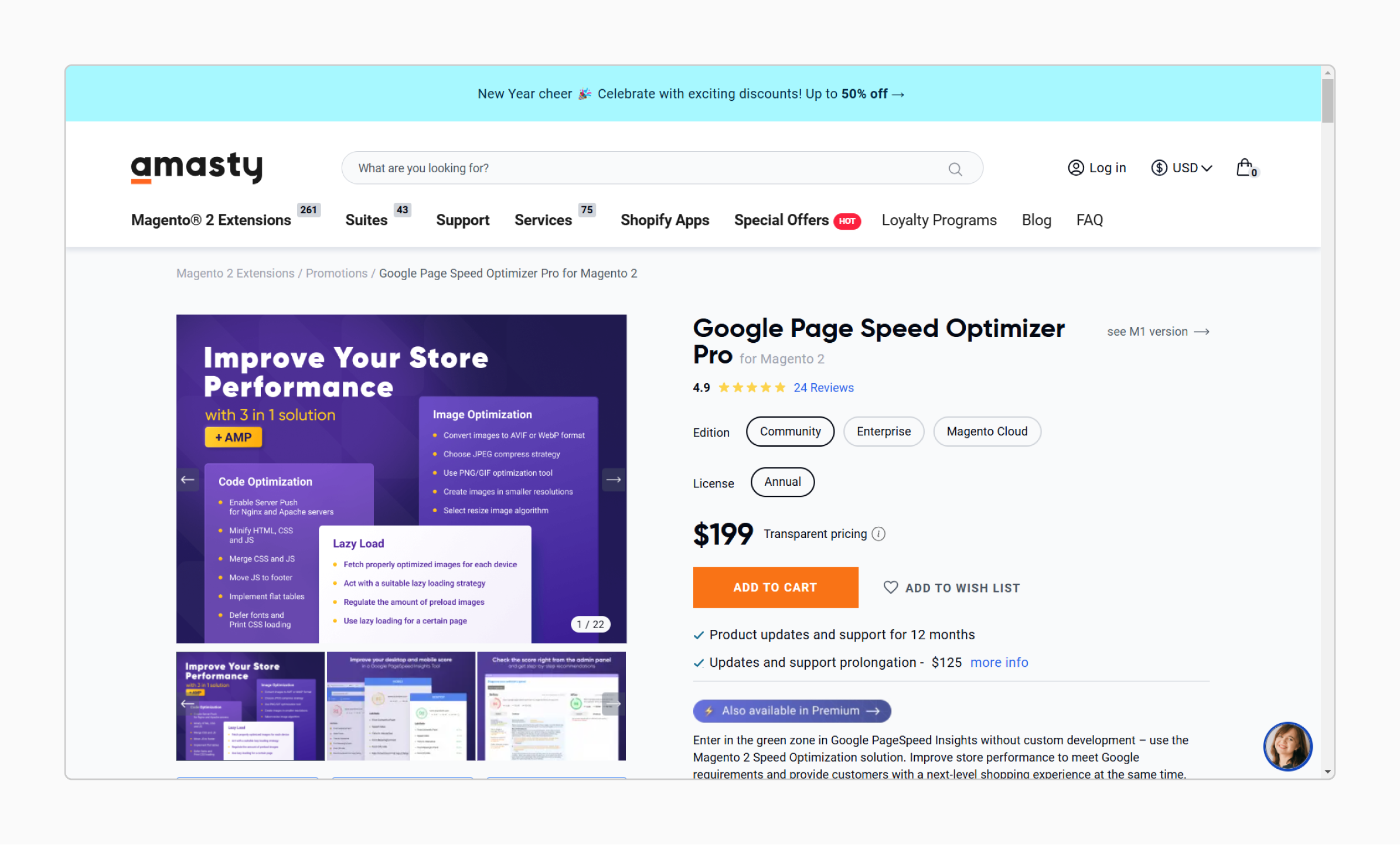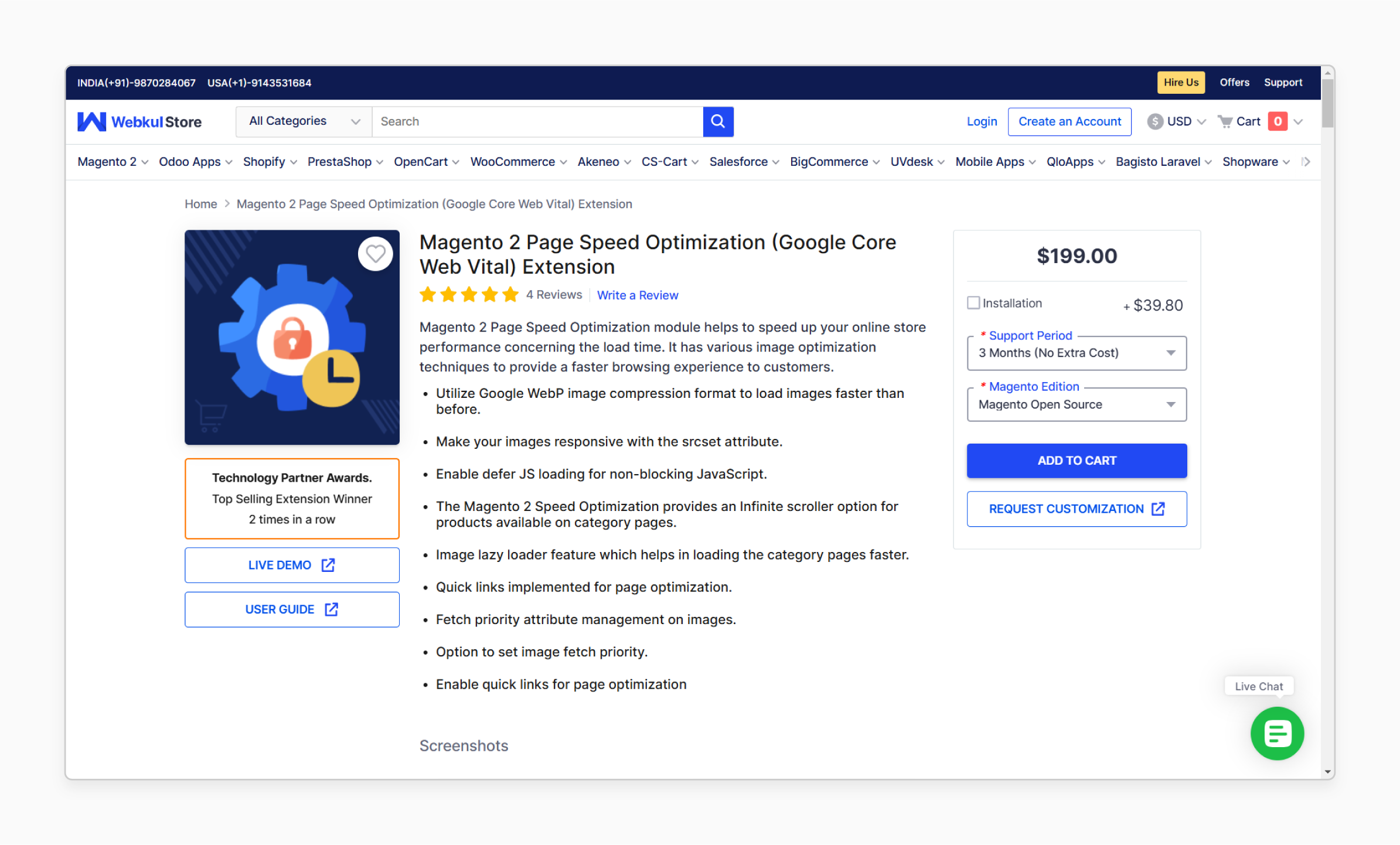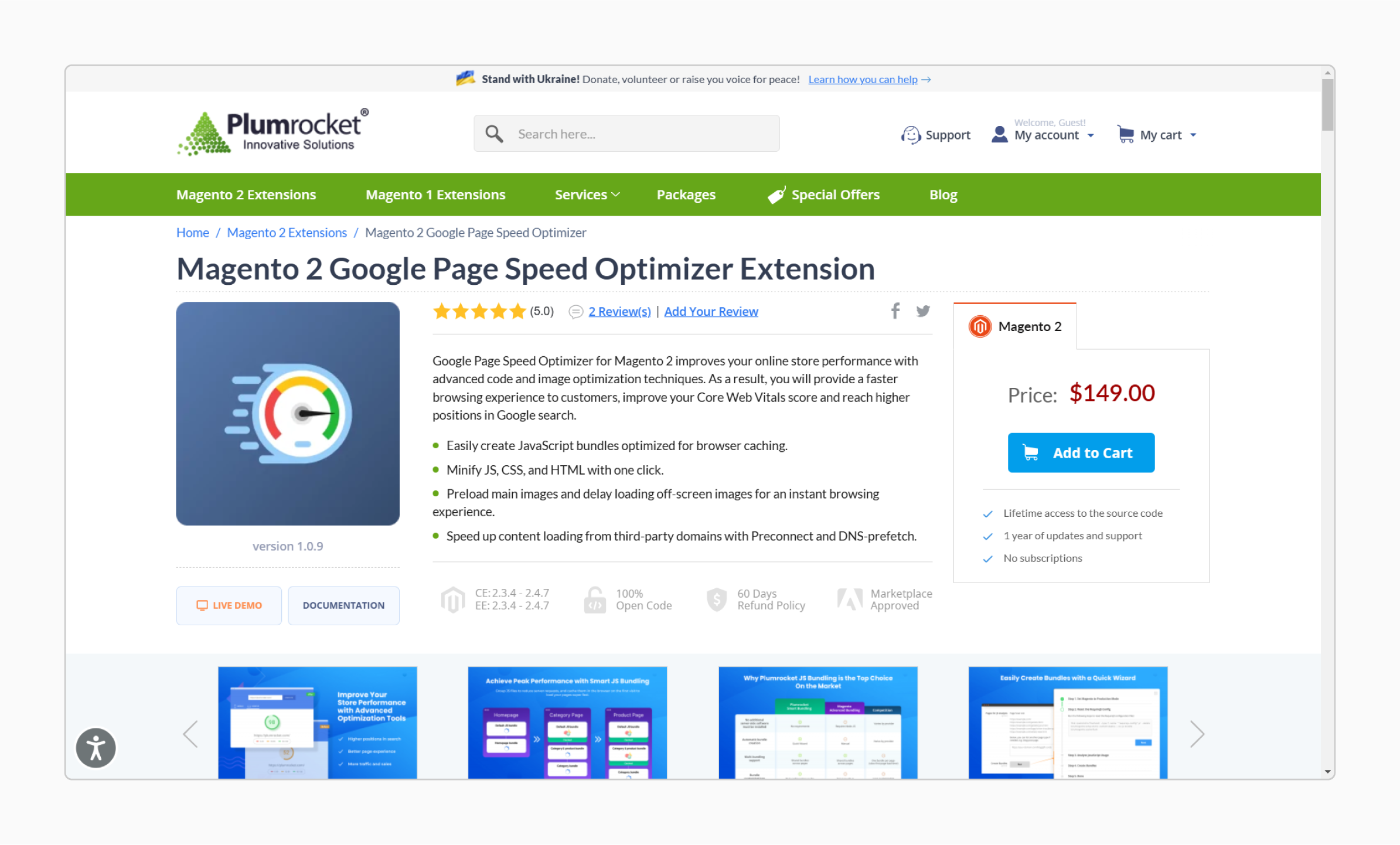
Magento 2 Speed Plugin: 8 Features and Best Practices
Did you know sites that load within 2 seconds have a 15% higher conversion rate? Magento 2 speed plugin ensures your store delivers lightning-fast performance, enhancing user experience.
In this article, we will explore the features, providers, and best practices of the Magento 2 speed plugin.
Key Takeaways
-
Choose the right speed plugin based on your store's needs.
-
Actionable strategies enhance your store’s speed beyond plugins.
-
Faster loading times boost SEO rankings and increase conversions.
-
Minimize HTTP requests and improve overall site efficiency.
-
Maintain a fast, secure, and up-to-date Magento store.
What are Magento 2 Speed Plugins?
Magento 2 speed plugins are specialized extensions designed for performance optimization of Magento 2 stores.
The loading speed optimizer extension enhances website speed by:
-
Implementing caching mechanisms
-
Minifying JavaScript and CSS
-
Optimizing images
These Magento 2 extensions enable lazy loading and integration with CDNs. It also addresses backend inefficiencies by improving database performance and reducing server load. Faster website speeds improve user experience and increase conversion rates.
Popular options like Amasty Full Page Cache and NitroPack offer solutions. It also enhances Magento 2 store performance.
8 Key Features of Magento 2 Speed Plugin
1. Caching Mechanisms
-
Caching enhances content delivery and reduces server load. These plugins generate and serve static HTML versions of web pages. It helps bypass database queries and PHP processing for frequently accessed pages.
-
They also ensure that static resources, including images and JavaScript, are stored on the user's device. Caching mechanisms like Redis and Varnish enable faster loading during subsequent visits.
2. JavaScript and CSS Optimization
-
Modern websites rely on JavaScript and CSS for functionality and styling. The unoptimized files can slow down performance.
-
It removes unnecessary spaces and code from JavaScript and CSS files to reduce file sizes.
-
The plugin combines multiple JavaScript and CSS files to reduce the number of HTTP requests.
-
It prioritizes loading essential resources while delaying or asynchronously loading non-critical scripts. It improves perceived page speed.
3. Image Optimization
-
Images often account for the largest portion of a webpage’s load time. Optimizing them can significantly boost speed.
-
It reduces file sizes without compromising quality using algorithms like WebP.
-
These plugins defer the loading of images outside the user’s viewport. You should only load them as the user scrolls down the page.
4. Content Delivery Network (CDN) Integration
-
A CDN enhances global performance by delivering content from servers closest to the user’s location.
-
CDNs globally store and serve static assets, including CSS and JavaScript. It helps reduce latency.
-
It ensures that traffic is distributed evenly across servers for uninterrupted performance.
5. Database Optimization
-
Magento 2 relies heavily on its database. Inefficiencies here can cause performance bottlenecks.
-
Plugins identify and optimize slow-running queries to improve database response times.
-
It also helps remove redundant or outdated data, such as logs and temporary files. It keeps the database lightweight and efficient.
6. Lazy Loading
-
Lazy loading is a technique to prioritize loading visible content. It defers non-visible elements.
-
It reduces the initial page load time by only loading images or scripts when users scroll to them.
-
It is ideal for stores with image-heavy catalogs. It ensures a smoother browsing experience.
7. Performance Monitoring and Reports
-
Advanced speed plugins often include tools to track and analyze website performance.
-
It provides real-time metrics into:
1. Load times
2. Page size
3. Server response times
-
The plugin highlights specific areas for improvement, such as oversized images or unminified code.
8. GZIP Compression
-
The plugin compresses files before they are sent to the browser. It reduces data transfer times and improves speed.
-
It is particularly effective for compressing:
1. HTML
2. JavaScript
3. CSS files
-
It also minimizes bandwidth usage.
Top 3 Magento 2 Speed Plugins
1. Google Page Speed Optimizer for Magento 2 - Amasty

Amasty’s Google page speed optimizer enters the green zone in Google PageSpeed Insights. It is done without custom development. The extension improves store performance to meet Google requirements. It also provides customers with a next-level shopping experience. It is compatible with Magento 2.4.7-p2, 2.4.6-p6, and 2.4.5-p8.
Key Features:
-
Optimize page experience on desktops and mobiles
-
Display images in the next-gen AVIF or WebP format
-
Automatically improve JS, CSS, and HTML code structure
-
Compress media files and defer offscreen images using Lazy Load
-
Apply smart JS Bundling and Server Push
-
Explore the built-in diagnostics tool with configuration tips
-
Speed up image optimization using the Imagick library
-
Compatibility with AWS Remote Storage
-
Hyva-ready storefront
-
Mage-OS compatible
Price:
-
Magento Community Edition: $199 (12 months)
-
Magento Enterprise Edition: $499 (12 months)
-
Magento Cloud Edition: $799 (12 months)
2. Magento 2 Page Speed Optimization Extension - Webkul

Webkul’s page speed optimization module speeds up your online store performance regarding load time. It has various image optimization techniques. These help provide a faster browsing experience to customers. It is compatible with Magento 2.0.x, 2.1.x, 2.2.x, 2.3.x, and 2.4.x.
Key Features:
-
Utilize Google WebP image compression format to load images faster than before
-
Make your images responsive with the srcset attribute
-
Enable defer JS loading for non-blocking JavaScript
-
Provides an Infinite scroller option for products available on category pages
-
The image lazy loader feature helps load the category pages faster
-
Quick links implemented for page optimization
-
Fetch priority attribute management on images
-
Option to set image fetch priority
-
Enable quick links for page optimization
Price:
-
Magento Open Source Edition: $298 (12 months)
-
Magento Adobe Commerce Edition: $597 (12 months)
3. Magento 2 Page Speed Optimization Extension - Plumrocket

Plumrocket’s page speed optimization extension improves your online store performance. It is done with advanced code and image optimization techniques. It helps you provide a faster browsing experience to customers. It improves your Core Web Vitals score and enables you to reach higher positions in Google searches. It is compatible with Magento 2.3.4 - 2.4.7.
Key Features:
-
Easily create JavaScript bundles optimized for browser caching
-
Minify JS, CSS, and HTML with one click
-
Preload main images and delay loading off-screen images for an instant browsing experience
-
Speed up content loading from third-party domains with Preconnect and DNS-prefetch.
Price: $149 (12 months)
How to Choose the Right Speed Plugin for Your Store?
1. Understand Your Store's Requirements
-
You should have a clear understanding of your store's unique needs. Speed plugins are often designed for specific platforms like:
1. Magento
2. WooCommerce
3. Shopify
-
Ensure the plugin is explicitly built for your Magento eCommerce system. A large catalog or multimedia-rich content may require advanced caching or load-balancing capabilities.
-
Look for plugins that offer mobile-specific optimizations. These include reducing resource-heavy scripts on smaller screens.
2. Focus on Usability and User Experience
-
Not all store owners are technical experts. The plugin should be usable.
-
Many plugins offer quick setup wizards to simplify the onboarding process. Beginners benefit from plugins with pre-configured, performance-optimized settings.
-
For tech-savvy users, ensure the plugin offers granular controls over:
1. Caching
2. File exclusions
3. Other optimizations
-
Avoid overly complex menus or elements that increase DOM size. Minimize the use of resource-heavy features like sliders and animations. Use web-safe fonts or host fonts locally to reduce external requests.
3. Evaluate Core Features
-
The right speed plugin should include powerful features tailored to your performance goals.
-
Full-page, browser, and object caching reduce server load and improve page load times.
-
Plugins like TinyPNG or ShortPixel compress and resize images automatically. It helps maintain quality.
-
Minify CSS, JavaScript, and HTML files to reduce file sizes and improve rendering speed.
-
Load images and other non-critical resources only when needed, reducing initial load time.
-
Clean up unused data, expired transients, and orphaned database entries to keep your store’s backend lean.
4. Consider Performance Analytics
-
A good plugin should provide insights into how it can improve your store. View performance metrics like:
1. Load times
2. Server response times
3. Resource utilization
-
Identify conflicts or poorly performing features quickly. Ensure the plugin works smoothly with performance tools. These include Google PageSpeed Insights and GTmetrix.
5. Check Compatibility with Themes and Extensions
-
Speed plugins often interact with:
1. Extensions
2. Themes
3. Third-party tools
-
Look for reviews or documentation that highlight compatibility issues.
-
Choose plugins with active developer communities or responsive support teams. These help quickly resolve conflicts.
6. Research Reputation and Reviews
-
You should check the plugin's reliability. Read customer reviews and testimonials from store owners with similar setups.
-
A frequently updated plugin is more likely to be secure and compatible with your platform's latest version.
-
Premium plugins often come with dedicated customer support to address technical issues promptly.
7. Prioritize Security
-
Installing plugins from unreliable sources can expose your store to vulnerabilities. Ensure the safety of the plugin by downloading plugins. These can be downloaded from official repositories or trusted marketplaces.
-
Some plugins undergo security audits to ensure compliance with industry standards.
8. Test and Monitor Performance
-
You should also test the impact on your store’s speed. Use trial periods or demos to test features without fully committing.
-
Monitor improvements by focusing on key performance indicators like:
1. First Contentful Paint: It measures the time it takes for the first visible content to be rendered on a user's screen.
2. Cumulative Layout Shift: It quantifies the visual stability of a webpage by measuring the total unexpected layout shifts that occur as content loads.
-
You should also monitor overall UX using tools like:
1. Google PageSpeed Insights
2. GTmetrix
3. Pingdom Tools
-
Ensure you can revert to a previous configuration if the plugin causes unexpected issues.
Best Practices for Optimizing Speed Beyond Plugins
1. Optimize Hosting
-
Upgrade to a high-performance hosting plan designed for your platform, such as:
1. VPS
2. Dedicated hosting
3. Managed hosting
-
Opt for a reliable hosting provider like MGT-Commerce. Avoid shared hosting for high-traffic stores, as resources are shared among multiple sites.
-
Use server-level caching technologies like Varnish or Memcached.
-
Distribute your content globally using a CDN. It helps ensure faster loading times for users, regardless of their location.
2. Optimize Images
-
Opt for modern formats like WebP or AVIF. It offers superior compression without sacrificing quality.
-
Use tools like TinyPNG or Adobe Photoshop to reduce file sizes before uploading.
-
Serve appropriately sized images for different devices using the HTML element or CSS.
3. Minimize HTTP Requests
-
Consolidate CSS and JavaScript files where possible to reduce the number of requests.
-
Eliminate unused CSS, JavaScript, and plugins that add unnecessary weight to your pages.
-
Inline only the CSS needed for above-the-fold content and defer the rest.
4. Enable Browser Caching
-
Store static resources like images and JavaScript in the user's browser cache for quicker subsequent visits.
-
Configure your .htaccess file or server settings to set proper resource caching headers.
5. Implement Lazy Loading
-
Load images and videos only when visible in the viewport using lazy loading techniques.
-
Defer loading third-party resources like:
1. Chat widgets
2. Analytics scripts
3. Social media embeds
-
It should be done until after the primary content has loaded.
6. Reduce DNS Lookups
-
Minimize the number of unique domains serving resources. It is done by consolidating them into fewer domains where feasible.
-
Use DNS prefetching to reduce latency for external resources.
7. Optimize JavaScript Execution
-
Use the async or defer attributes for JavaScript. It prevents them from blocking the rendering of your page.
-
Audit and eliminate unnecessary JavaScript libraries and frameworks.
-
Load only the JavaScript required for specific pages or sections.
8. Use Gzip or Brotli Compression
-
Compress files before sending them to users' browsers to reduce data transfer sizes.
-
Check your server settings to enable Gzip or Brotli compression for all text-based resources.
-
Gzip compression is a server-side technology that reduces the size of web files, such as HTML, CSS, and JavaScript.
-
Brotli compression is a modern, high-efficiency algorithm. It compresses web files like HTML, CSS, and JavaScript more effectively than Gzip.
9. Monitor and Optimize Database Performance
-
Remove unnecessary data from the database, such as:
1. Expired transients
2. Revisions
3. Old logs
-
Use indexing to speed up database queries and reduce load times for dynamic content.
-
Configure your platform to save only a limited number of post revisions.
10. Adopt Modern Web Technologies
-
Upgrade your server to support HTTP/2 or HTTP/3 protocols. It enables faster resource loading and reduced latency.
-
Use service workers to cache resources and enable offline capabilities. Use preloading and prefetching tags to load essential assets earlier.
11. Keep Your Website Up-to-Date
-
Ensure your CMS, plugins, and extensions are updated to their latest versions. It enables better performance and security.
-
Clean up outdated legacy code or scripts that may slow down your store.
12. Reduce Third-Party Scripts
-
Limit the number of external resources, such as:
1. Analytics
2. Marketing tags
3. Social media widgets
-
Use tools like Google Tag Manager to manage scripts more efficiently and load them asynchronously.
FAQs
1. How do Magento 2 speed plugins enhance performance at the bottom of the page?
Magento 2 speed plugins improve performance at the bottom of the page. It is by enabling lazy loading for images and optimizing resource delivery. These techniques reduce page load times and ensure smooth scrolling.
2. How does a speed optimizer for Magento 2 improve performance?
A speed optimizer for Magento 2 focuses on performance optimization. It is by minifying JavaScript and CSS, optimizing images, and enabling lazy loading. These enhancements ensure smooth browsing, particularly on dynamic pages.
3. Can Magento 2 extensions improve product page render times?
Specific Magento 2 extensions are designed to optimize product page render times. It is by reducing server load and implementing advanced caching mechanisms. It ensures faster access to product information and better customer satisfaction.
4. Why is performance optimization important for Magento 2 stores?
Performance optimization helps improve user experience and increase sales. Using a Magento 2 extension like a loading speed optimizer enhances site speed and reduces bounce rates. It also ensures smooth navigation across all pages.
Summary
Magento 2 speed plugins optimize eCommerce store performance and boost user experience. The article explores the key features of the plugin, including:
-
Serve static pages to reduce server load and improve performance.
-
Minify and combine JavaScript and CSS files to decrease size and enhance speed.
-
Compress images using formats like WebP and enable lazy loading.
-
Leverage CDNs to deliver content faster from servers closest to users.
Boost your store's speed and performance with Magento 2 speed plugins. Pair it with managed Magento hosting for a smooth shopping experience.










